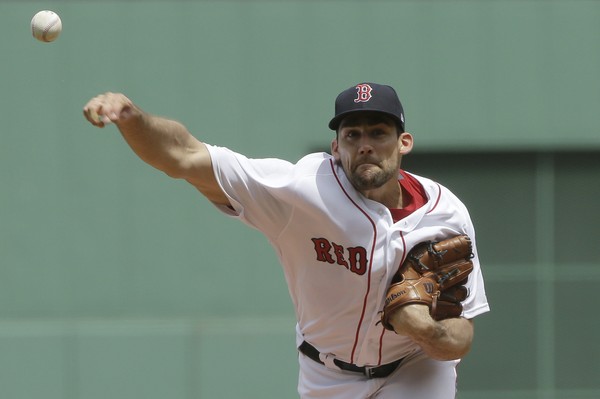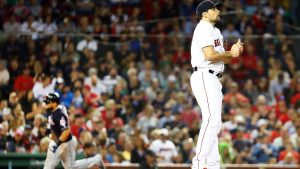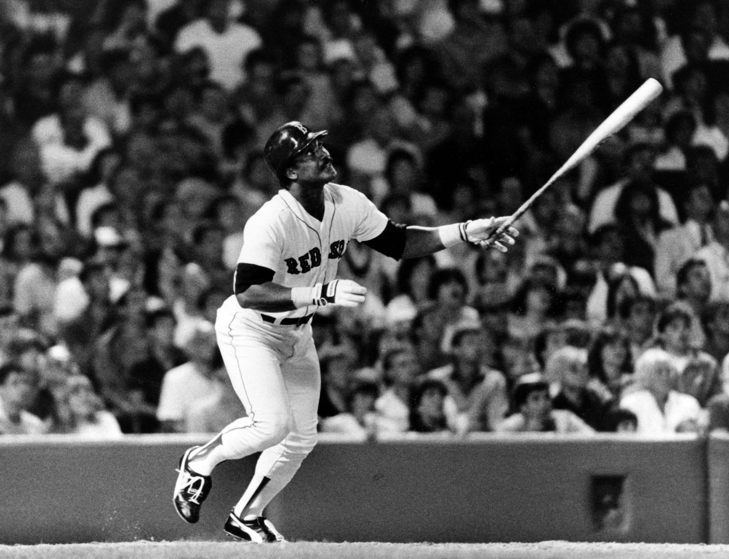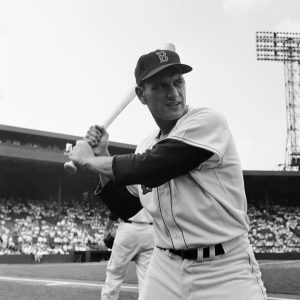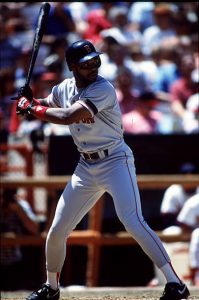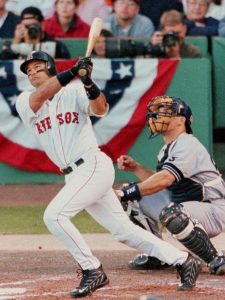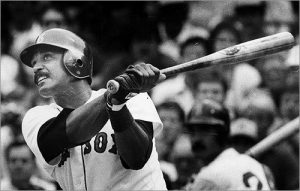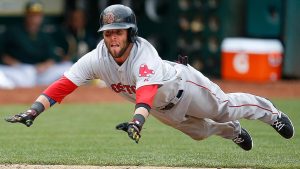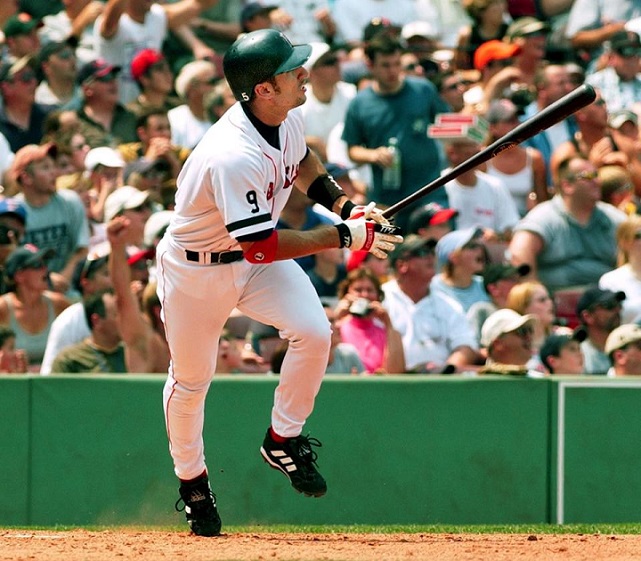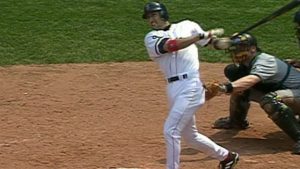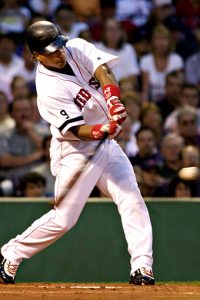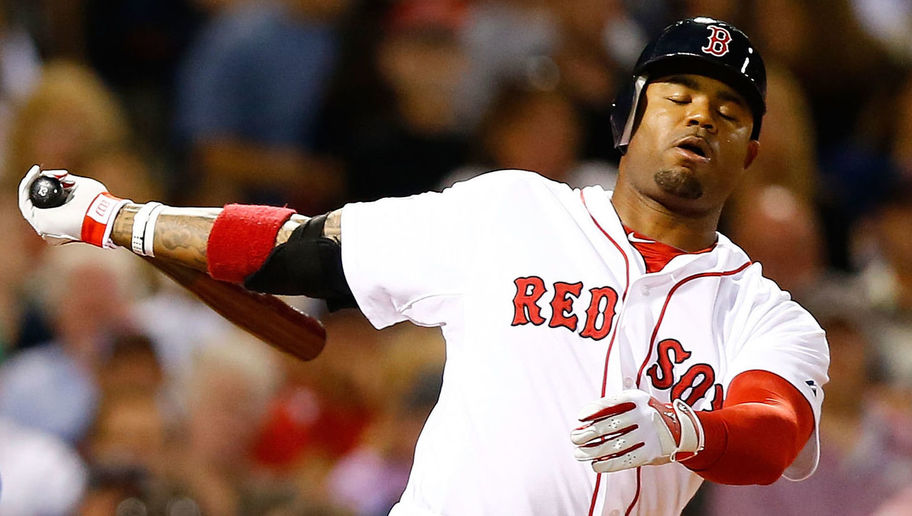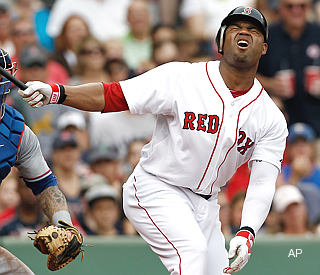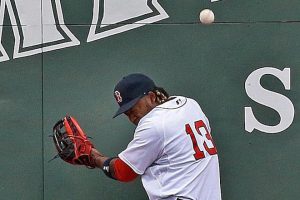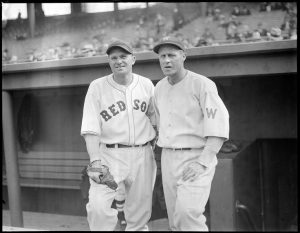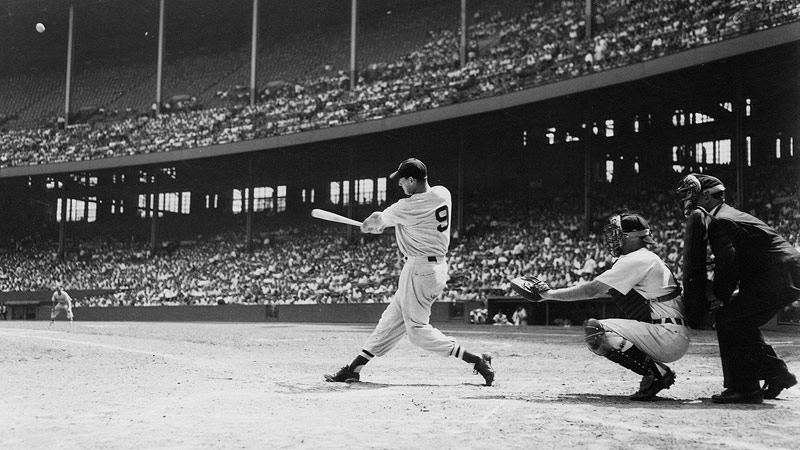With the pitchers and infielders all covered, it’s time to head to the outfield. Who are the greatest players to ever roam left field in front of the Green Monster?
Ted Williams
The greatest hitter who ever lived. I could go on and on writing about his statistics, they are mind-boggling. The last player to ever hit .400, Williams batted .356 over his first four seasons. He then went to war and missed the next three seasons. Where many guys return from war and have a hard time readjusting, Williams came back and won the MVP Award in his first year back.
Williams was called back to service for the Korean War. He left early in 1952 and returned in August 1953. After over a year fighting overseas, Williams did one of the most superhuman feats in sports history. Over 91 at-bats, having not played baseball in over a year and fighting a war during that time, Williams batted .410 and hit 13 home runs! That’s one home run every seven at-bats. He then never batted lower than .345 over the next four years, topping out with a .388 batting average during his age 38 season in 1957. In 1960, at the age of 41, Williams posted his best HR/AB ratio of his career, hitting 29 home runs in only 310 at-bats. If the DH existed back then, he could have kept going for several years.
Williams had an OPS over 1.000 every year of his career except 1959, when he played injured at age 40. He rebounded to a 1.096 OPS the following season and retired. If he had not missed time to the war, Williams would have hit close to 700 home runs, at which point he may have kept going to try to surpass Babe Ruth. He would likely have 3500 hits coupled with somewhere north of 2500 walks. His career 162 game average was .344 with 37 home runs, 130 RBI, 188 hits, 143 walks and a .482/.634/1.116 slash line.
Williams won two MVP Awards and was robbed of three others thanks to biased media members. He finished 2nd in four MVP votes and had three other top five finishes. Williams won two Triple Crowns, leading the league in average six times, home runs four times and RBI four times. Williams also led the league in on base percentage 12 times, slugging nine times and OPS 10 times.
Carl Yastrzemski
Yaz would rank first for almost any team, but in Boston he has to contend with the greatest ever for that honor. He did an admirable job following in Williams’ footsteps though, having a Hall of Fame career and holding several franchise records. Yastrzemski batted .285 with 452 home runs and 1844 runs batted in. He banged out 3419 base hits, 646 of which were doubles. Yaz of course played some first base and designated hitter, but he made his hay as a left fielder. He had over 2000 hits and 1000 RBI while playing left field.
Yaz’ 1967 season was historic, and he was the last player to win the Triple Crown Award for years before Miguel Cabrera accomplished the feat in 2012. Yaz led the Red Sox from a 9th place finish in 1966 to the 1967 AL pennant by batting .326 with 44 home runs and a 1.040 OPS. He would hit 40+ home runs three times in four seasons. Interestingly, immediately after that stretch he failed to hit even 20 homers in any of the next five seasons.
Yaz won three batting titles and led the league in on-base percentage five times. He made 18 All-Star Games and won the 1967 MVP Award. In addition to his hitting talents, Yaz was just as good with the glove. He won seven Gold Glove Awards as a left fielder, including one after he had been moved to first base for a few years. He returned to left field in 1977 and didn’t make a single error while picking up 16 assists.
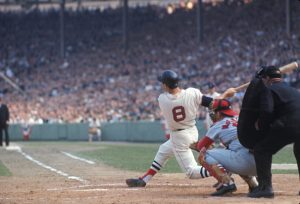
Carl Yastrzemski hitting home run as Tim McCarver and umpire Al Barlick watch at Fenway Park. 10/5/1967 CREDIT: (Photo by Neil Leifer/Sports Illustrated/Getty Images)
Jim Rice
Jim Rice is yet another Hall of Famer who spent his entire career with the Red Sox. He only had a stretch of 12 good years, but during that stretch he may have been the best hitter in baseball. Rice had a swift decline in the late 80’s or he would have coasted into the Hall of Fame earlier. After batting .304 with 350 home runs during that 12 year stretch, Rice batted only .263 with 31 home runs over his final three seasons.
Rice batted .298 for his career, hitting 382 home runs out of 2452 base hits, all with the Red Sox. His home runs rank him 4th on the franchise’s all-time list, while his base hits rank third behind Williams and Yaz. Rice hit 39 or more home runs all three seasons from 1977-79, averaging a season of .320 with 41 home runs and a .972 OPS. His 406 total bases in 1978 were the most by a player since Stan Musial in 1948, and the most by an American League player since Joe Dimaggio in 1937. He led the league in hits, home runs, RBI and OPS that season on way to winning the MVP.
In addition to his MVP Award, Jim Rice finished in the top five for the MVP vote five other times. He made eight All-Star Games and won two Silver Sluggers during the eighties. Silver Sluggers were not an award before 1980 or he surely would have won a few more. Rice led the league in home runs three times.
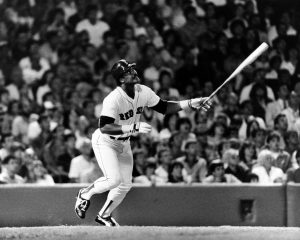
Jim Rice of the Red Sox hitting a home run,
Manny Ramirez
Manny has some of the greatest offensive numbers in history among right-handed batters. About half of that production came in Boston. As a Red Sox, Manny batted .312 with 274 home runs. 868 RBI and 1232 hits. His rate numbers are better than Yaz and Rice, at .411/.588/.999, but his counting stats fall far short as those two spent their entire careers in Boston. Manny also played during a hitter’s era when offensive numbers were much higher.
Of course, Manny had his drawbacks. Although never testing positive as a Red Sox, Manny did fail two drug tests before his career ended. It is hard to know when he first started using performance enhancers. He also asked to be traded on multiple occasions. Manny was known to take stretches off with phantom injuries. Needless to say, Manny wasn’t always good for team camaraderie. In addition to him spending less time here, these are reasons Manny comes in fourth on this list.
Manny’s real strong stretch lasted for six seasons, from when he was signed in 2001 until 2006. His play had dropped off in 2007 and before he was traded in 2008. During that six-year stretch Manny batted .316 with an average of 39 home runs and 119 RBI per season. There is no doubt, he was an offensive force. Manny also won the 2004 World Series MVP. He made eight All-Star Games, won six Silver Sluggers and finished in the top six for MVP three times.
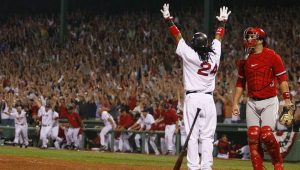
Manny Ramirez of the Boston Red Sox celebrates after connecting for a three-run home run to defeat the Los Angeles Angels, 6-3, in Game 2 of the ALDS at Fenway Park October 5, 2007 (Photo by Jim Rogash/Getty Images)
Mike Greenwell
“The Gator” wraps up the top five. Unfairly to him, Greenwell pales in comparison to the four above him on this list. The Red Sox have had quite the rich history in left field. Greenwell was no slouch, batting .303 for his career. When a career .300 hitter looks weak after the top four, that says something. Greenwell hit 130 home runs out of his 1400 career hits, all with the Red Sox. He missed a lot of time to injuries in the 90’s, holding back his stats, but Greenwell could hit. He had an excellent slash line of .368/.463/.831 for his career.
Greenwell started off his career hot, homering four times in 31 at-bats in September of 1985. He was one of the best young outfielders in the game during the late 80’s. He hit .328 with 19 home runs and a .956 OPS in 1987. Greenwell would follow that up with a .946 OPS in 1988, batting .325 with 22 home runs and 119 RBI. That season, Greenwell finished second in the MVP vote to Jose Canseco, which turned out to not be a very level playing field. In 1989 he batted .308 and drove in 95 more runs. Quite a stretch to begin his career, injuries are really what held him back later. His 162 game average for his career is a stellar .303 with 17 homers and 93 RBI.

Mike Greenwell of the Boston Red Sox watches the flight of his ball during an MLB game circa 1995 at Fenway Park.(Photo by Focus on Sport/Getty Images)
Honorable Mentions:
Duffy Lewis & Troy O’Leary
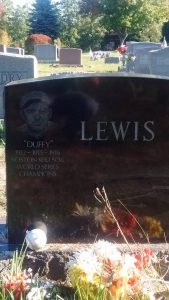
Duffy Lewis is buried not far from where I live. I visited his grave last fall.
Greatest Right-Handed Pitchers
Greatest Left-Handed Pitchers
Greatest Relief Pitchers
Greatest Catchers
Greatest First Basemen
Greatest Second Basemen
Greatest Third Basemen
Greatest Shortstops
